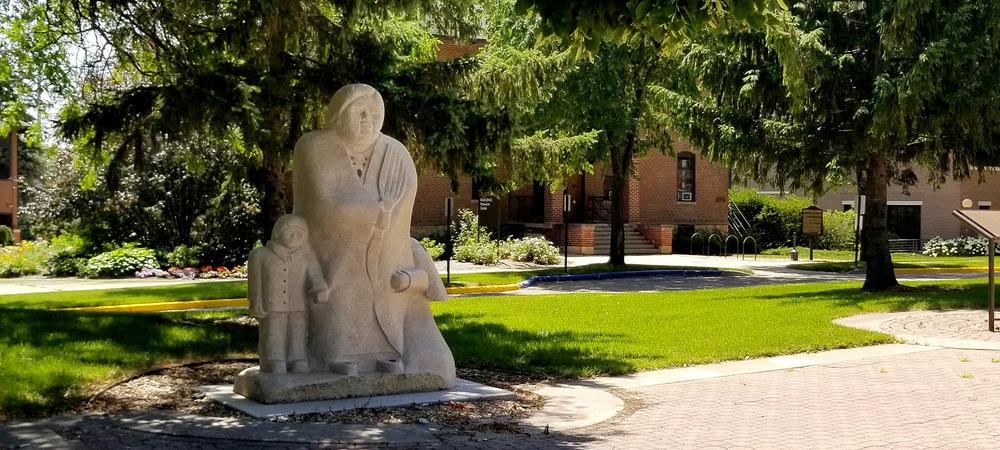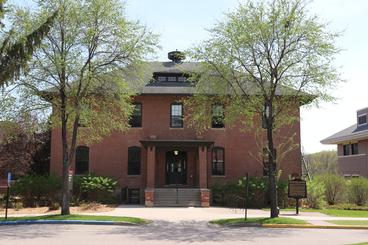
About Morris
- Mission & Vision
- National Rankings
- A Unique Campus History
- Accreditation
- American Indian Boarding Schools in Morris
- Enrollment Management and Institutional Effectiveness and Research
- Native American Student Life
- Native American Student Success Program (NASS)
- Organizational Structure and Campus Governance
- Policies & Administration
- Student Achievement Data
- Student Learning Outcomes
- UMN Morris Land Acknowledgment
History of American Indian Boarding Schools in Morris

Before there was a University of Minnesota presence in Morris, the site housed an American Indian boarding school established in 1887 by the Sisters of Mercy community of the Catholic Church under contract with the U.S. government. The U.S. government began directly operating the Morris Industrial School for Indians on the site in 1897; one building from the school remains on campus. Sixteen mission and federally operated American Indian boarding schools in Minnesota and hundreds across the country separated children from their families and attempted to eliminate Native languages and cultures, with intergenerational impacts still felt across Indian Country.
In 1909, the federal government closed the school, transferring the campus and buildings to the State of Minnesota. The federal legislation and corresponding state statute stipulated that American Indian students be admitted to future educational institutions on the site “on terms of equality” with other students and “free of charge for tuition.” This federal mandate has its roots in treaty law and has been UMN Morris policy since it was established as the University’s public liberal arts campus in 1960.
The American Indian Boarding Schools Collection of the Briggs Library on campus houses a collection of materials related to off-reservation boarding schools.
We recognize that "The social, emotional, spiritual, and cultural devastation from boarding school experiences have passed down to Native American individuals, families, communities and Tribal Nations today," to use the words of the National Native American Boarding School Healing Coalition, of which UMN Morris is a member. Student Counseling at the University of Minnesota Morris offers mental health care and resources for all of our students. As licensed and experienced providers, they have special training in multicultural issues and cultural competency.
Frequently Asked Questions
What did the school become after the American Indian boarding school closed?
In 1910, the University of Minnesota established the West Central School of Agriculture (WCSA) on what is now the Morris campus. The WCSA educated area high school students in a boarding school environment until 1963.
When and how did UMN Morris leadership become aware that there may be remains interred, unmarked, on campus grounds?
Research work during summer 2018 conducted by a then-Morris student and faculty member on the boarding schools identified more specific evidence of student deaths and the possibility of burials at the schools.
What prompted that research? Were there suspicions that the research could lead to this sort of information?
The 2018 research was part of a larger ongoing effort to expand the campus’s collection of material related to the boarding schools. This effort dates back to at least 2010 and builds on earlier work by Professor Bert Ahern. Tribal communities have long known that deaths occurred at boarding schools, and Ahern’s 1984 article in Minnesota History refers to deaths at the Morris boarding schools. A student research assistant in the spring of 2018 located news items in Morris newspapers from the period that refer to the deaths of fewer than 10 students. The search was expanded that summer to include UMN Morris archival holdings, recently digitized materials from the Bureau of Catholic Indian Missions, and materials held at the Stevens County Courthouse. Conversations were also held with the local Catholic priest and with a member of the parish cemetery board.
What specifically was learned in the 2018 research that has led to further conversations?
The 2018 research suggested that at least three, and possibly as many as seven, Indian children who died at the boarding school in the late 1800s and early 1900s may have been interred in a cemetery plot on or near the present day Morris campus. Generally, the deceased children’s remains were returned to their parents, and documentation exists for several such situations. No documentation, however, has been discovered or located to show the disposition of the remains of the children in question.
Has any subsequent research been conducted to learn more about the possible existence or location of these remains?
Additional research by Morris faculty and students has revealed no specific evidence of a cemetery for the burial of children who died while at the boarding school. We can also not say with certainty, however, that no such cemetery existed. We have been unable to determine where a cemetery may have been located and the disposition of any individuals buried there, although research continues. Tribal consultation, including work with Tribal Historic Preservation Officers, is central to our plans moving forward.
Is there a cemetery near or next to the campus?
Yes. Calvary Cemetery, owned and operated by the Assumption Catholic Church of Morris, and Summit Cemetery are located adjacent to the campus. Research suggests that some of the Sisters of Mercy who established and worked at the American Indian boarding school may have been buried in Calvary Cemetery. There is no archival research suggesting that any children who died while at the boarding school were buried there.
What actions has the University taken to acknowledge these findings with the campus and larger community?
The University has widely shared the research news with Morris students, staff, and faculty. In April 2019, with the guidance of the campus’s American Indian Advisory Committee, as well as Dakota and Anishinaabe elders, the campus hosted a ceremonial gathering to inaugurate an era of truth-telling, understanding and healing regarding the history of this land. It was a first step in remembering the children and their families and communities that have been negatively impacted by the boarding school on this site and all those across Minnesota and our nation. The campus is indebted to the late Mr. Danny Seaboy of the Sisseton Wahpeton Sioux Tribe who led that gathering and the Woapipiyapi ceremony.
In November 2019, Mr. Seaboy again led the campus and Tribal leaders in a ceremony to bring support to UMN Morris students, children, and families of the boarding school era and all those carrying intergenerational trauma.
In November 2020, Annishinaabe cultural and spiritual advisors Mr. Darrell Kingbird Sr., citizen of the Red Lake Nation, and Mr. Naabekwa Adrian Liberty, citizen of the Leech Lake Band of Ojibwe, led the second annual ceremonial gathering to support Morris’s Native American community and our campus for understanding, healing, resilience, and strength. Auntie in Residence Tara Mason, a citizen of the White Earth Nation, provided cultural teachings and supported the ceremonies.
The third annual ceremony was October 30, 2021. Jerry Dearly, Lakota, Pine Ridge, was our cultural leader and guide for the ceremony, and Dawn Chase, Upper Sioux Community, assisted with preparations and the ceremony.
The 2022 ceremony was held September 15, 2022, led by spiritual elder Feron James Thunderhawk, Lakota. Diane Desrosiers, Sisseton Wahpeton Dakota, offered an introduction and foundational learning sessions, while Jacqueline Bird, Dakota/Mandan Hidasta Arikara, led women's prep for Native women.
In what other ways has UMN Morris worked to better understand and respond to this period of history?
The campus joined the National Native American Boarding School Healing Coalition in 2018 to further these efforts. We value their critical work in truth telling, understanding, and fostering healing from these heartbreaking traumas and losses.
Campus gatherings for healing have included programs by the National Native American Boarding School Healing Coalition and others to enhance understanding among all members of the campus community. Students, faculty, and staff have the opportunity to participate in workshops and panels throughout the academic year led by Native elders, scholars, and Indigenous students centered on truth-telling, increasing awareness, and building understanding about this traumatic era of U.S. educational history and federal Indian policy. Faculty and staff have participated in extended immersion programs held in partnership with Dakota and Anishinaabe Tribal Nations three of the last five summers, bringing greater understanding of this history, its connections to today, and the resilience and strength of Native peoples.
UMN Morris is committed to creating a university where Native American students can increasingly share, connect with, and deepen their knowledge of Indigenous peoples, nations, Tribes, languages, sovereignty, and lifeways; where Native cultures are more present and reflected in campus life; and where all members of our community benefit from greater knowledge and understanding regarding our shared histories and the people indigenous to this place.
A Teach-In held Saturday, November 6, 2021, provided background and information about continuing affects of Native American boarding schools. A second Teach-In was held Saturday, November 19, 2022.
How is the University engaging Tribal communities overall and on this issue specifically?
Campus leaders are guided by the UMN Morris American Indian Advisory Committee and Dakota and Anishinaabe elders. Dakota and Anishinaabe Tribal Nations and their interests and expertise will guide next steps. UMN Morris leaders respect Tribal sovereignty and recognize the deep losses connected to this history and its continuing impacts on families and communities. No action will be undertaken without their guidance and direction.